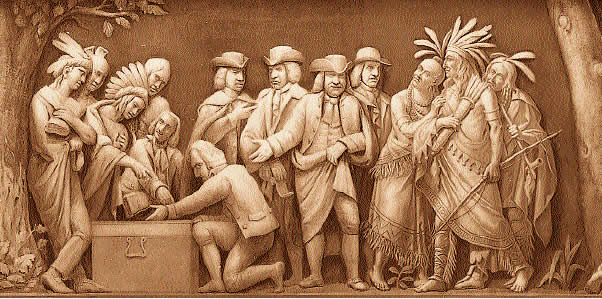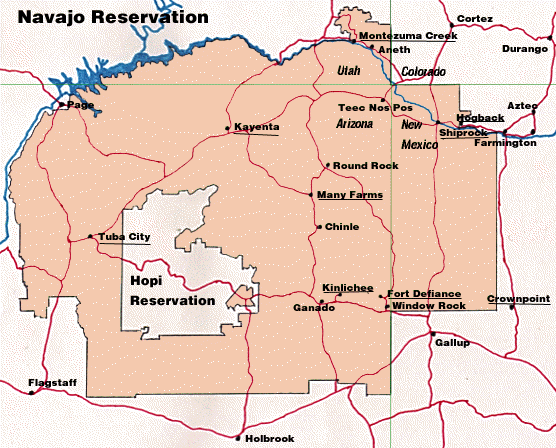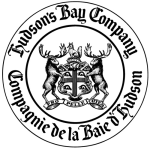|
|
Canku Ota |
|
|
(Many Paths) |
||
|
An Online Newsletter Celebrating Native America |
||
|
April 20, 2002 - Issue 59 |
||
|
|
||
|
This Date In |
||
|
North American Indian History |
||
|
from On This Date in North American Indian History at http://americanindian.net |
||
| Apr. 20, 1606: | According to the first charter of Virginia, issued today, part of the colonists goals are to civilize the natives. "...and may in time bring the infidels and savages, living in those parts, to human civility." |
|
|
|
| Apr. 21, 1869: | Donehogawa (Ely Samuel Parker) is appointed as the first Indian to be Commissioner of Indian Affairs. Donehogawa, a SENECA IROQUOIS, was trained as a lawyer and a civil engineer. Unable to find work in the white world, Donehogawa contacts his old friend Ulysses Grant. Grant makes him an aide, and they work together through much of the Civil War. Because of his excellent penmanship, Donehogawa draws up the surrender papers for Lee to sign at Appomattox. Promoted to Brigadier General, Ely Parker worked to settle many conflicts between whites and Indians. After Grant becomes President, he will be appointed as Indian Commissioner on this date. |
|
|
|
| Apr. 22, 1889: | The Oklahoma land rush begins. |
|
|
|

"William Penn and the Indians." (The frieze of the Rotunda of the United States Capitol contains a painted panorama depicting significant events in American history.) |
|
| Apr. 23, 1701: | Today, William Penn will sign a treaty of friendship at Philadelphia with representatives of the SUSQUAHANNA, SHAWNEE, GANAWESE, and the IROQUOIS. All parties will agree to act peaceably with each other. The treaty will be known as the "Articles of Agreement". |
|
|
|
| Apr. 24, 1802: | Today, the State of Georgia will cede its western lands to the United States, with the proviso that the Federal Government obtain the title to Indian lands as soon as "can be peaceably obtained on reasonable terms." |
|
|
|
| Apr. 25, 1774: | Michael Cresap is one of many "frontiersmen" in Kentucky who wishes to instigate a war with the local indians. He hopes that the Indians would lose the war, and be forced off their highly coveted lands. Today Cresap, and a few friends, come across a SHAWNEE and a DELAWARE Indian traveling through the woods. Cresap's group kills them both. |
|
|
|
| Apr. 26, 1906: |
A law is passed which grants the President to pick the CHEROKEE Chief. |
|
|
|
| Apr. 27, 1763: | Today, Pontiac will hold a council with a large group of OTTAWA, WYNADOT, and POTAWATOMI Indians. He will tell them of his plans to attack Fort Detroit. He will extol the virtues of returning to the old Indian ways, before the coming of the Europeans. |
|
|
|
| Apr. 28, 1882: |
Remnants of Loco's CHIRICAHUA APAPCHEs who fought in the battles south of Stein's Pass, and in Horseshoe Canyon, on April 23, 1882, are attacked today by Captain Tullius Tupper, Troops G, and M, 6th Cavalry, and a company of Indian scouts, 25 miles south of Cloverdale, Arizona. Six APACHEs are killed, and 72 head of livestock are seized, according to Army reports. The surviving Indians head toward Mexico. |
|
|
|
| Apr. 29, 1700: | Lemoyne d'Iberville today visits a PASCAGOULA Indian village, one day's walk from the French post at Biloxi. The PASCAGOULAs have been hit hard by disease brought by the Europeans. D'Iberville is impressed by the beauty of the PASCAGOULA women. |
|
|
|

|
|
| Apr. 30, 1860: | Fort Defiance, in northwestern Arizona, was the first fort to be build in NAVAJO country. Built near land used by Manuelito's NAVAJOs to graze their horses, an inevitable conflict begins when the army claims the grazing land for their own mounts. A series of raids on both sides leads to a full scale attack. On this date, Manuelito, and nearly 1,000 warriors attack Fort Defiance. The NAVAJOs capture a few outbuildings, but the soldiers soon regroup and volleys are exchanged throughout the rest of the day. The NAVAJOs will leave that night considering the message delivered. The Army will eventually retaliate. |
|
|
|
| May 1, 1833: | A census of the Creek upper towns shows 14,142 people, including 445 Negro slaves. |
|
|
|
 When a charter was granted to the "Governor and Company of Adventurers of England trading into Hudsons Bay" in 1670, the Company was constituted a sovereign power, subject only to the King. This sovereignty was to be exercised over a vast territory extending eastwards and westwards from Hudson Bay; here the Company held full royal power as the representative of His Majesty and in recognition of this it was granted a coat of arms suited to its dignity. |
|
| May 2, 1670: | King Charles of England gives all trade rights to "all the Landes Countreyes and Territoryes upon the Coastes and Confynes of the Seas" lying within the Hudson Strait to the Hudson’s Bay Company. This monopoly remains in effect until 1859. |
|
|
|
| May 3, 1493: | Today through tomorrow, the Pope divides the "new world" between the Spanish and the Portuguese. |
|
|
|
|
For Information on This Date in Canada visit our friends at: |
|
Canadian
Aboriginal News |
|
|
||
|
|
||
| Canku Ota is a free Newsletter celebrating Native America, its traditions and accomplishments . We do not provide subscriber or visitor names to anyone. Some articles presented in Canku Ota may contain copyright material. We have received appropriate permissions for republishing any articles. Material appearing here is distributed without profit or monetary gain to those who have expressed an interest. This is in accordance with Title 17 U.S.C. section 107. | ||
|
Canku Ota is a copyright © 2000, 2001, 2002 of Vicki Lockard and Paul Barry. |
||
|
|
|
|
|
The "Canku Ota - A Newsletter Celebrating Native America" web site and its design is the |
||
|
Copyright © 1999, 2000, 2001, 2002 of Paul C. Barry. |
||
|
All Rights Reserved. |
||
